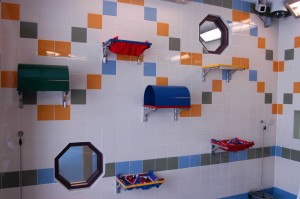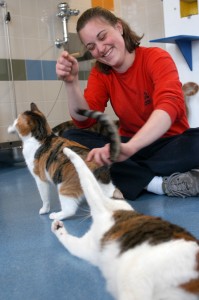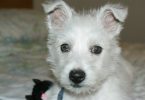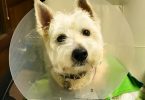Recently, mom was invited to attend an influencer summit sponsored by Iams and Eukanuba in Dayton Ohio. Unfortunately, I was not invited (no dogs at hotel). But anyway, I decided to let my mom go on the one condition that she gets in inside scoop on Iams pet care and she gives us full reports for my readers here on prestonspeaks.com Over the next couple of weeks I will feature blogs my mom has written about her experiences at the behind the blog influencer summit. To catch up read these blogs : Iams Research Center – Part 1, IAMS and Animal Testing, Behind the Paw 2011 – Manufacturing Tour, Behind the Paw – Day One ,and Behind the Paw 2011
To catch up on the first half of this post please go here ==> Iams Research Center – Part 1,
Each animal when they are brought into the research center has a life plan developed for them by their animal care team. This plan will specify what kind of studies the animal will take part in, which kind of training they will receive, and when they will retire. These plans are regularly reviewed and adjusted based on how the animal is doing and if health issues are discovered. It is estimated that P&G invests $10,000 into every animal before their first year of age. Also, no animal is involved in any research until they are one year old. So what do they do that first year? They have a wonderful program in place for these animals. First, the animal will go into a foster program in which volunteers take the puppies and kittens home for several months so they can be exposed to a home environment. Then they return to the research campus and the cats go to Kitten Kindergarden where they are exposed to different surfaces, stairs, slides, toys, people, etc. The dogs go into puppy pre-school where all dogs of similar age get to play together and are also exposed to different things. At six months of age all animals are spayed or neutered. They are also microchiped. Cats are never declawed and dogs ears, tails, etc are never surgery changed due to appearance. No dogs are ever de-barked as well. During this year the animals receive extensive trainings. It is clicker positive re-enforcement and they are taught a mix of skills needed for when they get adopted later on in life and things they will do to be able to do for the medical research. For example, the cats are taught to go on artificial grass mats instead of a litter box.
IAMS staff also discussed with us what kind of testing they conduct on these animals. No terminal studies (lost of life) are ever conducted. They do split plate studies also called comparative food studies. After the animal eats the food their waste is collected for analysis. So they deal in alot of poop there. The only types of procedures permitted are those equivalent to those done on humans such as blood work, urinalysis, fecal studies, and immune cell analysis. They never will induce disease on healthy animals. If they do need to test on unhealthy animals (for their vet food line for example) they have extensive partnerships with area vets and will contact pet parents that their animal already suffers from an aliment to participate in the study. As I mentioned in a previous post IAMS also conducts in home studies with volunteers in the area as well.
 The living conditions are exceptional at the P& G research center. I was so impressed with the attention they gave to the animal’s living environment. All the dogs kennels have nice outdoor play areas that rival nice dog parks with toys, items to climb, shade, etc. The kennels were also state of the art. They even control the heating and air from the animals level. It doesn’t matter if it too warm at 5 feet if it is the idea temp at 2 feet and on floor level. We walked into a kennel and the animals were so calm. They just stood there waiting to be petted. They didn’t jump on the kennel doors or even bark at us. I was very amazed at how well behaved they were. The cat area was just as impressive. The cats live in a cage free environment. There are many multi-layer hammocks and shelves/beds on the walls and the cats have access to an out-door screened in play area. Each room I say has about 10-15 cats that live together.
The living conditions are exceptional at the P& G research center. I was so impressed with the attention they gave to the animal’s living environment. All the dogs kennels have nice outdoor play areas that rival nice dog parks with toys, items to climb, shade, etc. The kennels were also state of the art. They even control the heating and air from the animals level. It doesn’t matter if it too warm at 5 feet if it is the idea temp at 2 feet and on floor level. We walked into a kennel and the animals were so calm. They just stood there waiting to be petted. They didn’t jump on the kennel doors or even bark at us. I was very amazed at how well behaved they were. The cat area was just as impressive. The cats live in a cage free environment. There are many multi-layer hammocks and shelves/beds on the walls and the cats have access to an out-door screened in play area. Each room I say has about 10-15 cats that live together.
 Yes, IAMS adopts their animals out. Dogs retire around six to nine years of age while cats retire around eight years old. Sometimes younger animals also go into retirement if they have behavior issues, health problems, or just don’t thrive in a kennel environment. P&G has very strict adoption criteria for anyone who wants to adopt. They must be indoor animals only, no declawing of the cats, they have an extensive interview process, and an adoption contract. If the new animal doesn’t work out they are always welcome to come back and they go back into the adoption program. About 70% of these animals are adopted by P&G employees.
Yes, IAMS adopts their animals out. Dogs retire around six to nine years of age while cats retire around eight years old. Sometimes younger animals also go into retirement if they have behavior issues, health problems, or just don’t thrive in a kennel environment. P&G has very strict adoption criteria for anyone who wants to adopt. They must be indoor animals only, no declawing of the cats, they have an extensive interview process, and an adoption contract. If the new animal doesn’t work out they are always welcome to come back and they go back into the adoption program. About 70% of these animals are adopted by P&G employees.
Overall, i was very impressed with the P&G Research Center. I really think they are taking good care of these animals and the facility is outstanding. I think they had done extensive research on how to make these animals as happy and healthy as possible. I hope I have answered many of your questions but if not feel free to comment below.
<em>Disclosure- Iams did cover my travel expenses and hotel to attend the summit. However, Opinions are my own.</em>









Great post Preston!!